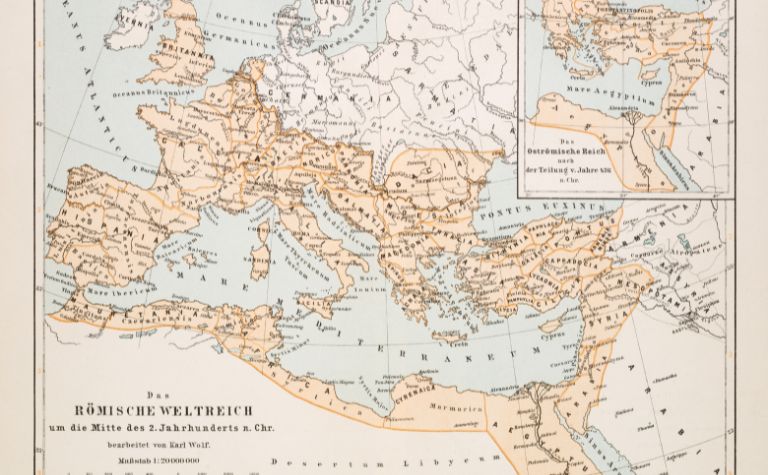The Vikings and the Romans were among the most dominant military forces of their times.
Since the Roman Empire spanned large parts of Europe in its heyday, it is not unreasonable to assume that the two powers would have met in battle. However, the Romans actually preceded the Vikings, ruling out this possibility.
The Viking era in Europe came after the Roman period in terms of historical chronology.
Whereas the Western Roman Empire collapsed in 476 A.D., the Viking Age only began in 793 A.D.
And although the Eastern Roman Empire continued to exist until 1453 A.D., it was not centered on Rome and Europe.
This article will provide an overview of the timelines of the Viking and Roman epochs and explain why Viking and Roman armies never met on the battleground.

Timeline of the Vikings: Overview
The Vikings were Norse pirates who, driven by the limited availability of resources in their Scandinavian homelands, set out to raid the ships and coastal towns of other nations.
The Vikings were advanced shipbuilders, avid explorers, and settlers and traded widely in goods and slaves.
Because Norse culture was primarily oral, the beginning of the Viking Age is usually dated to their first violent contact with Europeans.
The historical record sets the date as 793 A.D. That year, the Vikings raided a monastery at Lindisfarne on the north-eastern coast of England. [1]
This does not mean that Vikings did not exist before this date, only that there is no known record of them any earlier.
Monasteries were a favorite target of Viking attacks because they were wealthy.
Monasteries and churches were also poorly guarded, based on the expectation that no Christian would attack them.
The Vikings–who were pagan–had no such qualms.
Over the next 300 years, the Vikings continued to raid coastal towns and cities all over Europe.
After spreading a pall of terror over Christian Europe, they ventured further south, attacking the Muslim kingdoms of Andalusia and North Africa.
Swedish Vikings expanded eastwards via the Baltic Sea.
Over the era of their dominance on the seas, the Vikings:
- Sacked Paris
- Built Dublin
- Administered large parts of North-Eastern England
- Colonized Normandy in the North of present-day France
- Traveled as far as Constantinople in the east and Newfoundland in the west [2]
However, the Vikings weren’t merely pirates and raiders. They were also great settlers and traders who established cooperative relations and alliances with many kingdoms over time.
It was these successes that eventually led to the unraveling of the Viking Age.
The Vikings who had settled in Normandy converted to Christianity and allied with the Frankish emperors of present-day France.
In 1066 A.D., the descendants of these Vikings–who were known as Normans–defeated the Anglo-Saxons at the Battle of Hastings and established their hold over England.
Thus, the Age of the Vikings ended in the 11th century when the seafaring Vikings settled.
Although they were a significant force for only 300 years, the Vikings left behind a considerable legacy, most notably in their influence on the modern English language.

Timeline of the Romans: Overview
Rome was founded in 753 B.C. and grew rapidly. Over the next eight centuries, it expanded into a trading hub and cultivated a vast professional army.
Eventually, it emerged as an empire, an event usually marked by the ascension of Augustus Caesar as the first Roman Emperor in the first century B.C. [3]
Within a little more than a century, Rome’s Empire was the most expansive in the entire Western world.
Apart from much of continental Europe, Rome also ruled large parts of Britain and had territories in West Asia, North Africa (including Egypt), and islands in the Mediterranean. [4]
In 285 A.D., Emperor Diocletian split his unwieldy kingdom into two halves, each of which was to be ruled by one of his two sons.
The Western Roman Empire continued to be run out of Rome, and the Eastern Roman Empire, also known as the Byzantine Empire, was based out of Constantinople (present-day Istanbul in Turkey).
After a golden era of prosperity, the Western Roman Empire began declining in the 5th century A.D.
Wracked by internal divisions and external invasions, it started losing territories quickly. The Vandals sacked Rome, and the Huns invaded Gaul. [5]
Finally, in 476 A.D., this branch of the empire collapsed spectacularly when its last Emperor, Romulus Augustus, was deposed by a Germanic prince named Odovacar.
The Eastern Roman Empire continued for another millennium, only falling to the Ottoman Turks in 1453 A.D.
The influence of the Roman Empire on history, especially Western history, is too vast to quantify.
From the Latin alphabet and the Romance languages to the Gregorian calendar and the rise of Christianity in the modern world, its legacy is still evident today.

Did the Vikings and Romans Ever Fight?
The Vikings and Romans never fought. The Western Roman Empire had collapsed by the time of the Viking Age, and the Vikings had good relations with the Eastern Roman Empire.
They fought for the Byzantine Emperors in battle and provided guards for their protection.
The Roman Empire began before the Viking Age and ended after it.
Despite this, the Vikings and Romans did not fight each other in battle because the Western Roman Empire, whose territories spanned the areas where such conflicts were most likely to arise, collapsed more than two centuries before the Vikings began their raids. [6]
Although the Eastern Roman Empire outlasted the Vikings by centuries, it was more remote from the territories the Vikings regularly raided.
However, in their travels, the Vikings did get as far as Constantinople. They did so by sailing via the Baltic Sea and Russian rivers.
Moreover, the Vikings had good relations with the Eastern Roman Empire and even provided the Byzantine rulers with soldiers who fought on their side in many battles.
The Vikings also made up the Varangian Guard–the personal bodyguard of the Byzantine Emperors–who protected them from dangers such as the constant threat of assassination. [7]
Thus the Vikings and the Roman Empire–as it existed at the time of the Vikings–were allies. For this reason, they did not fight at any time in history.
Conclusion
Vikings came after the fall of the Western Roman Empire and never fought the Eastern Roman Empire, with whom they had friendly relations.
